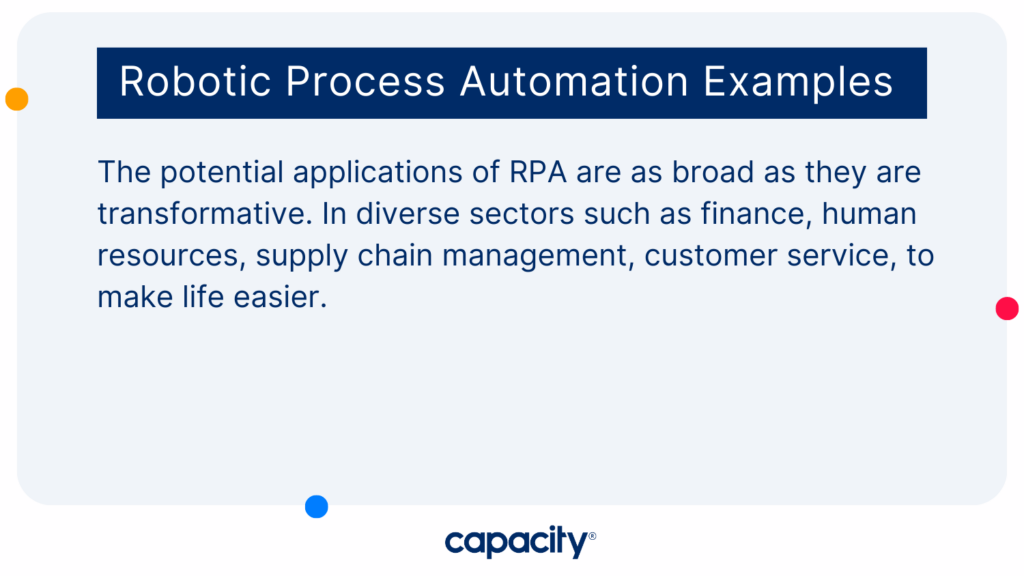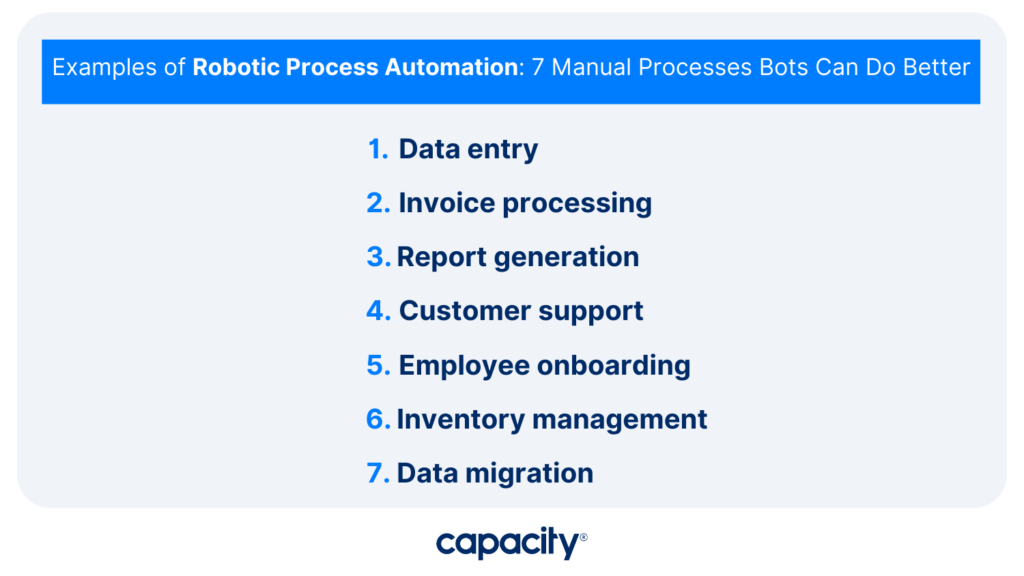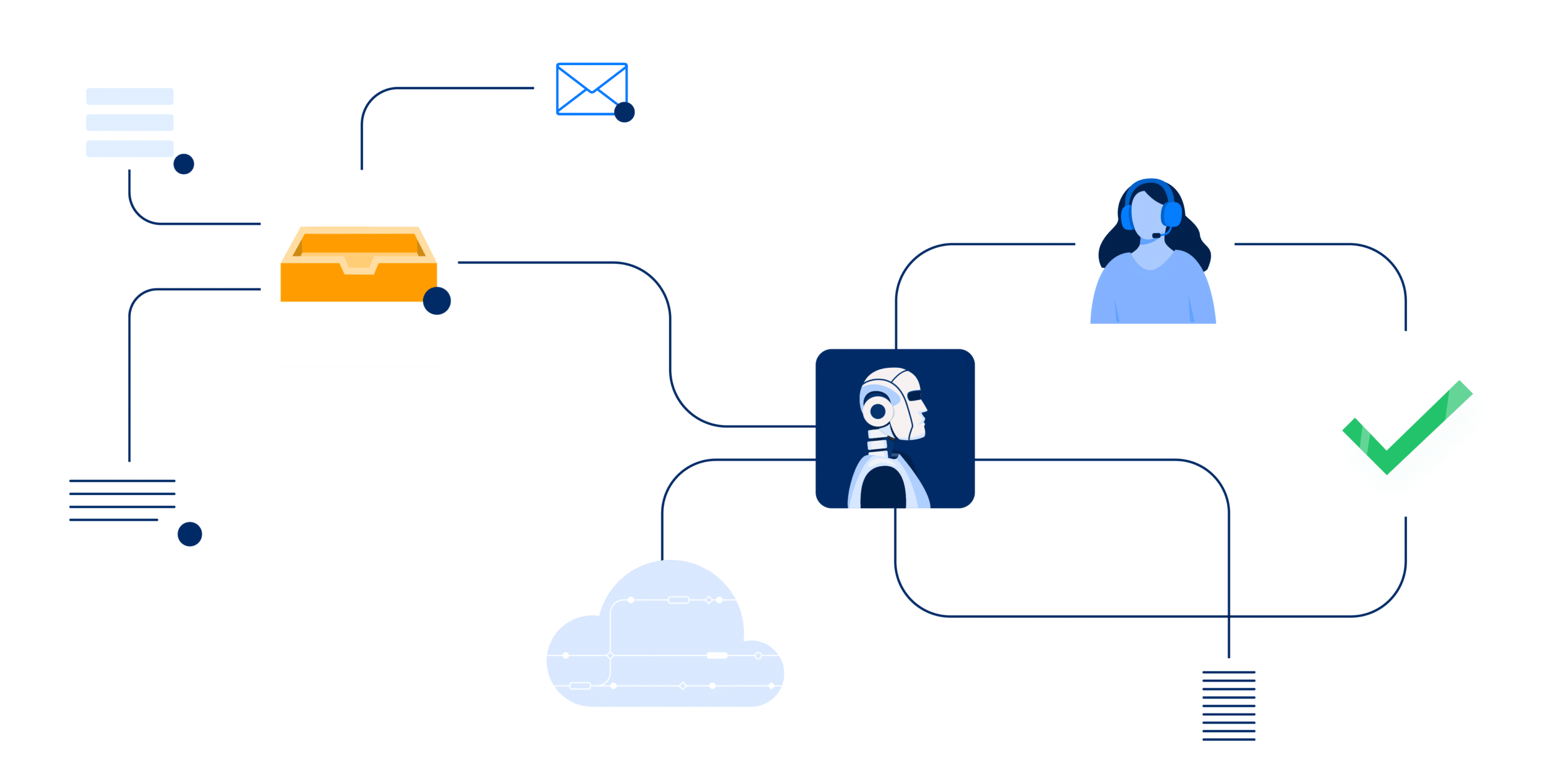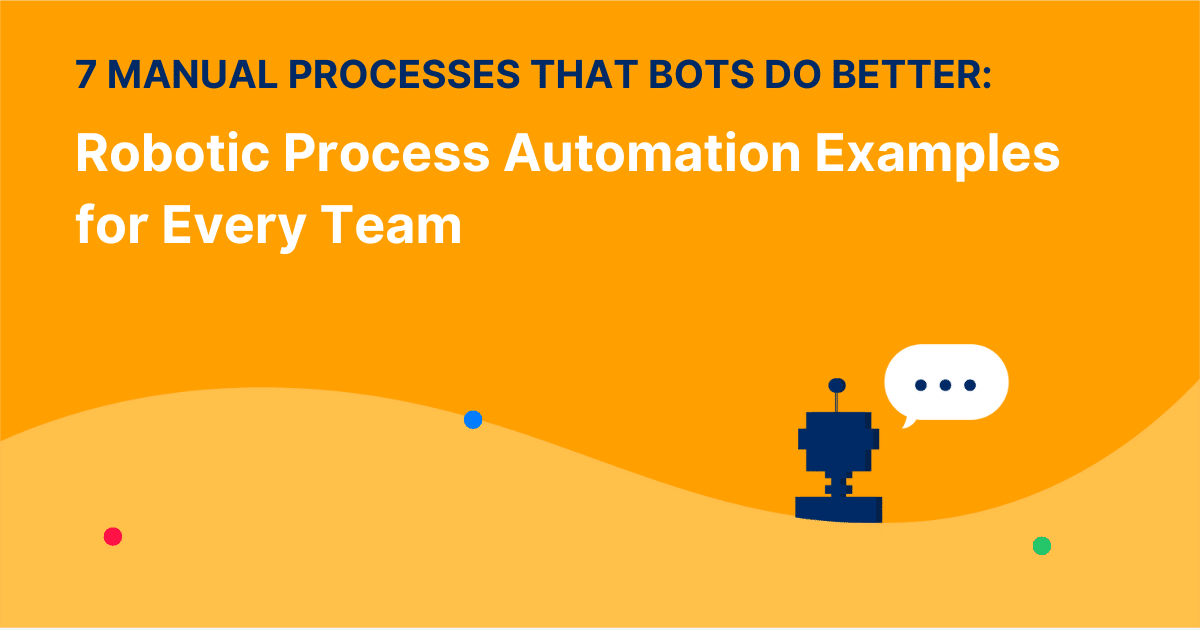Ever wished you could clone your best workers? Enter Robotic Process Automation (RPA), a revolutionary technology designed to streamline business processes and boost productivity by automating repetitive tasks. Picture a software bot, tirelessly replicating the exact actions a human would take when interacting with digital systems, 24/7, error-free. From data entry to invoice processing, these bots can do it all and more. That’s why we’re digging into some robotic process automation examples so you can start exploring how RPA can transform your work.
Don’t worry. RPA is not just about replacing human effort with bots. It’s about strategic efficiency. In fact, over 78% of companies are already implementing RPA in their processes whereas an additional 16% are planning to implement RPA in the next 3 years. But unlike traditional automation, which often requires coding and significant IT involvement, RPA is designed to mimic human interactions with digital systems, meaning it can be deployed without a major system overhaul. With RPA bots handling the tasks that humans find mundane and tiresome, your team is freed up to focus on strategic, high-value tasks that truly need their expertise.
The potential of RPA for your business

The potential applications of RPA are as broad as they are transformative. In diverse sectors such as finance, human resources, supply chain management, customer service, and more, RPA is there to make life easier. In a recent global survey, Deloitte actually reports that RPA continues to meet and exceed expectations across multiple dimensions. 92% of companies report that RPA has led to improved compliance, 90% report improved quality, 86% report improved productivity, and 59% report reduced costs.
Even better, with advancements in machine learning and artificial intelligence, RPA is evolving from rule-based operations to sophisticated decision-making tasks. The bots are here, and they’re ready to drive significant business transformation. So, read on for seven real-world robotic process automation examples that can help you reimagine what’s possible in your business.
What is Robotic Process Automation?

Robotic Process Automation (RPA) is an innovative technology that uses software bots or “robots” to automate repetitive, rule-based tasks that were traditionally performed by humans. Basically, the principle behind RPA is to mimic human interactions with digital systems to execute business processes. From data entry to invoice processing, RPA bots can perform various tasks without human intervention.
Overall, RPA is built on the idea of streamlining business operations to boost productivity and efficiency. Unlike traditional automation, RPA does not require any coding or major system overhaul. Instead, RPA bots interact with applications in the same way a human would, making them easy to deploy. These bots can work continuously without the need for breaks, reducing the time it takes to perform tasks, and they can complete jobs with a high degree of accuracy, minimizing errors.
The applications of RPA are broad and transformative. In sectors such as finance, human resources, supply chain management, customer service, and more, RPA can automate routine tasks. In the end, this allows professionals to focus on strategic, high-value tasks. Not to mention, 83% of organizations have proactive IT operations implemented. Furthermore, with advancements in machine learning and artificial intelligence, RPA systems are becoming increasingly sophisticated. Expand the possibilities for automation and drive significant business transformation with RPA.
Examples of Robotic Process Automation: 7 Manual Processes Bots Can Do Better

1. Data entry:
Manual Process: Traditionally, employees spend significant time manually entering data from various sources into systems or spreadsheets, which is not only time-consuming but also prone to errors.
RPA Solution: RPA bots can automate data entry tasks by extracting information from structured or unstructured data sources and populating the required fields accurately and efficiently. This application of RPA then reduces manual effort, speeds up the process, and minimizes errors.
2. Invoice processing:
Manual Process: In many businesses, accounts payable teams manually receive, review, and process invoices, often leading to delays, data entry errors, and increased processing time.
RPA Solution: When you use RPA, invoice processing can be streamlined. RPA bots automatically capture relevant data from invoices, validate information, cross-check with purchase orders, and initiate approval workflows. This dramatically reduces manual intervention, accelerates the process, and improves accuracy and efficiency.
3. Report generation:
Manual Process: Generating reports often involves manually gathering data from multiple sources, compiling it, and formatting the report, which can be time-consuming and prone to human errors.
RPA Solution: With RPA, report generation can be automated. Basically, RPA bots extract data from various systems. Then, they consolidate it, perform calculations or analyses, and generate reports in the desired format. This process saves time, eliminates errors, and enables real-time reporting.
4. Customer support:
Manual Process: Customer support agents typically manually handle customer queries, searching for relevant information and performing repetitive tasks like account verifications.
RPA Solution: RPA bots can significantly improve customer support. They instantly retrieve customer data from multiple systems, provide agents with relevant information, automate responses to common queries, and perform routine tasks like account updates or password resets. This then boosts response times, enhances customer satisfaction, and frees up agents to handle more complex issues.
5. Employee onboarding:
Manual Process: HR teams manually collect and process new employee information, which involves paperwork, data entry, and manual coordination with various departments.
RPA Solution: RPA bots can automate many aspects of employee onboarding, from gathering information and populating HR systems to triggering background checks and generating offer letters. This streamlines the onboarding process, reduces errors, and enhances the new employee experience.
6. Inventory management:
Manual Process: Inventory managers often manually track inventory levels, update spreadsheets, and initiate manual purchase orders, leading to stockouts or excess inventory.
RPA Solution: RPA can optimize inventory management. Bots monitor inventory levels in real-time, automatically update inventory records, generate purchase orders based on predefined thresholds, and integrate with suppliers’ systems for seamless ordering. This then reduces errors, ensures timely stock replenishment, and can lead to a more efficient supply chain.
7. Data migration:
Manual Process: During system upgrades or migrations, organizations often manually transfer data from legacy systems to new platforms, a task that’s time-consuming and prone to data errors or inconsistencies.
RPA Solution: RPA bots can automate data migration by extracting data from the legacy system, transforming it as per the new system’s requirements, and populating the target system accurately. This speeds up the migration process, minimizes errors, and ensures data integrity.
In a word, Robotic Process Automation (RPA) has the potential to significantly streamline business processes across various industries. When you automate repetitive tasks, you free up human resources to concentrate on value-driven activities. RPA is evolving alongside advancements in AI and machine learning, making it increasingly capable of sophisticated tasks and critical decision-making processes.
But remember, RPA is about empowering your workforce, not replacing them. With a wide range of applications and the promise of increased efficiency and accuracy, RPA offers substantial benefits. So, it’s time to explore how this transformative technology can drive growth and productivity in your organization.
Drive better work with RPA. Try automation today with Capacity, or request a personalized demo!

The Guide to Support Automation
Discover:
- The different types of AI
- A framework for applying support automation
- Tips for choosing solutions





